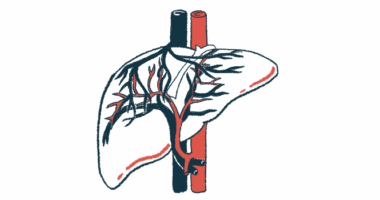Study finds a new player behind liver scarring in biliary atresia
CXCL6 protein identified as liver damage marker, potential treatment target

A new study has uncovered a key mechanism behind the liver scarring seen in biliary atresia (BA), a rare liver disease in infants. Two proteins, CXCL6 and MMP7, may be working together to drive this damage, according to researchers.
The discovery provides a novel marker for the disease in CXCL6 and also suggests potential targets for treatment.
The study, “CXCL6 Is a Novel Biliary Marker and a Downstream Target of MMP7 in Biliary Atresia,” was published in Hepatology Research.
Biliary atresia’s effect on the liver
Biliary atresia is a congenital condition in which the bile ducts — a series of tubes that carry the digestive fluid bile out of the liver and to the intestines — are absent or blocked. As a result, bile flow is stalled (a condition called cholestasis), and bile builds up in the liver, which can lead to liver damage and scarring (fibrosis).
Previous research has shown that the MMP7 protein is found at higher levels in the blood and liver tissue of babies with biliary atresia. It is also a known marker of liver fibrosis in these patients.
Other studies have pointed out MMP7’s potential as a diagnostic biomarker for the rare liver disease and a marker that can distinguish between biliary atresia and other causes of cholestasis in infants.
Still, the mechanism by which MMP7 may contribute to liver damage in biliary atresia remains unclear. CXCL6 is a signaling protein that attracts certain immune cells to sites of inflammation, and that has been linked to fibrosis, including liver fibrosis.
However, the levels of CXCL6 and whether it is correlated with liver fibrosis remain unknown in BA, the researchers wrote.
A link between two proteins
To gain more insight, scientists in China analyzed blood and liver samples from dozens of infants with biliary atresia, children with other causes of cholestasis, and children with healthy liver tissue.
In line with prior findings, they found MMP7 levels were significantly higher in blood and liver cells from infants with biliary atresia. CXCL6 levels were also significantly elevated, but not as much as MMP7, in samples from the biliary atresia group.
In addition, in both blood and liver tissue, higher levels of MMP7 were significantly associated with higher CXCL6 levels. Like MMP7, higher levels of CXCL6 were significantly linked to more advanced liver fibrosis in biliary atresia.
“CXCL6 demonstrated similar [level] characteristics with MMP7 in BA, and both were only up-regulated in BA but not in non-BA [cholestasis] when compared with normal controls, indicating CXCL6 and MMP7 were BA-specific biomarkers,” the researchers wrote.
When analyzing the diagnostic potential of these proteins, the researchers found MMP7 was superior to CXCL6 at distinguishing infants with biliary atresia from those with other causes of cholestasis and those without liver disease.
Further liver tissue analyses indicated the two proteins are both produced by biliary epithelial cells (BECs), which line bile ducts and can stimulate inflammatory damage upon injury. The two proteins were also found to physically interact.
New potential treatment targets
To further explore the relationship between these two proteins, the researchers conducted tests using lab-grown BECs. The scientists found that when they suppressed MMP7 production, CXCL6 levels also decreased. Conversely, increasing MMP7 levels led to an increase in CXCL6 levels.
Based on these data, the researchers concluded that one of the functions of MMP7 must be to promote CXCL6 production.
Notably, CXCL6 is known to be involved in molecular signaling pathways that help to control the activity of certain immune cells. The researchers speculated that increased CXCL6 levels could alter immune cell activity to promote liver fibrosis.
If that’s true and if CXCL6 levels can be modulated by targeting MMP7, then these two proteins “may serve as potential targets to alleviate liver fibrosis in BA,” the researchers wrote.
The scientists stressed, however, that further investigations will be needed to pin down the molecular functions of MMP7 and CXCL6, and to explore their potential use as treatment targets in biliary atresia.








